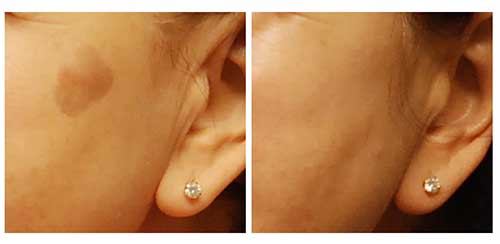
Skin Tag and Mole Removal
Moles or nevi are flat or elevated skin growths that have a collection of pigment or melanin causing them to be a variety of colors such as pink, red, tan, brown, or black.
Skin tags are small, usually harmless skin growths that are very common. They typically occur after midlife, are painless and are likely to occur in skin folds such as around the neck, underarms, and groin area. Most skin tags are small (although a few can get fairly large), are skin-colored and can occasionally bleed when irritated.
Seborrheic Keratoses Removal
Growths called Keratoses are also common in mid-life and can be classified as seborrheic or actinic. Seborrheic keratoses are noncancerous (benign) wart-like growths on the surface of the skin that can feel velvety, vary in color from yellow, light brown, dark brown or even black, grow and become irritated or itchy. They are typically located on the face, chest, shoulders, and back.
Actinic keratoses are small, rough, raised areas found on skin that has been exposed to the sun over a long period of time. Over many years, some actinic keratoses may develop into a type of skin cancer. Risk factors include having fair skin, long-term daily sun exposure or tanning beds, multiple and severe sunburns early in life and older age. Actinic keratoses are usually found on the face, scalp, back of the hands, chest, or other sun-exposed areas. They may be gray, pink, red, or the same color as the skin. Often, they have a white or yellow “sand-papery” scale on top and some lesions may be easier to feel than see.
Most skin growths are benign or non-cancerous and are either present at birth or develop over time most commonly in sun-exposed areas of the body. It is important to watch moles and skin lesions carefully for changes that could signify potential skin cancer such as asymmetry, irregular borders, dark/black color, multicolored or changing colors and large diameters. If any of these occur, prompt evaluation from a health care provider is recommended.
How it Works
Benign skin growths can be unsightly and annoying, prompting many people to desire removal. In the past, treatments usually consisted of “freezing” the lesion with liquid nitrogen, shaving it off with a blade or removing it as a biopsy which requires stitches. All of these are likely to develop scarring. With laser technology, it is possible to remove these skin growths quickly, with minimal pain, downtime and scarring compared to other procedures.
During Treatment
Before the skin tag laser removal treatment, your skin will be cleaned and your eyes will be protected with safety goggles. Depending on the size or number of skin lesions, the area may be numbed with topical and/or injectable lidocaine. A laser handpiece that looks similar to a pen will be positioned above the skin. When the laser energy is applied, a rapid succession of snapping sounds will occur. Most patients experience minimal pain especially if numbing was applied. The handpiece will be moved around until the skin lesion has been removed. The procedure normally takes about 5-15 minutes, depending on the size and number of lesions.
After Treatment
Any large lesions will be dressed with an antibiotic ointment and gauze. The smaller ones usually do not require any significant post-care treatment. The clinician will provide you with post-care instructions and recommend a healing cream. Most people find the area to look irritated for about 3-5 days with complete healing at around 1-2 weeks*. View more of our before and after Skin Blemish Removal results here.
If you are interested in learning more about laser treatments for Skin Growth Removal, please schedule a complimentary consultation at Rejuvenation Clinic!



